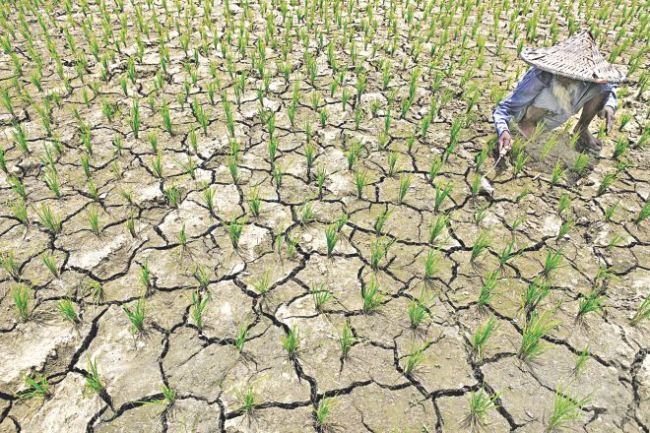The presence of excessive salt in drinking water in the southwestern coastal districts of Bangladesh is posing multiple health risks, including that of high blood pressure, kidney failure and diarrhea.
It also causes pre-eclampsia to which expecting mothers are particularly vulnerable.
The World Health Organization and the Food and Agriculture Organization recommend consuming at maximum 5 grams of salt per day with food and drinks. But people of this salinity-affected region take up to 16 grams of salt just by drinking water, according to research.
It also causes pre-eclampsia to which expecting mothers are particularly vulnerable.
The World Health Organization and the Food and Agriculture Organization recommend consuming at maximum 5 grams of salt per day with food and drinks. But people of this salinity-affected region take up to 16 grams of salt just by drinking water, according to research.

“Hypertension patients are more predominant here than in any other area I have worked in before,” said Mozammel Haque, medical officer of the 50-bed Dakop Upazila Health Complex in Khulna.
According to its health bulletin in 2012, more than half of the 5,384 patients admitted to the hospital in 2011 suffered form various ailments associated with salinity.
And around 60 percent of the patients admitted there in 2011 died of hypertension and other salinity-related diseases.
“Salinity of water is the precipitating factor of HTN (hypertension) in this region,” the bulletin says.
Home to some 50,000 people, Dakop is a classic example of inland salinity intrusion, which is robbing the people and the region of livelihood and agriculture.
Like in many other adjacent areas of this region, fresh drinking water is scarce in the entire upazila, thanks to extreme salinity.
But it is not just Dakop. A 2011 bulletin of Khulna Medical College Hospital shows that more than half of all the patients admitted to the hospital in 2011 had various diseases linked to salinity.
Earlier, a study on expecting mothers visiting the Dakop health complex for treatment identified a range of health problems with potential links to increased salinity, including hypertension, miscarriage, kidney failure, skin disease, acute respiratory infection and diarrhea.
The research conducted by the Imperial College of London and Bangladesh Center for Advanced Studies between July 2008 and March 2010 found that when the region runs out of drinking water in summer, salinity level in its ground water and river water rises.
Up to 39 percent of expecting mothers who drink shallow tube well water suffered from hypertension, with another 7 percent suffering from pre-eclampsia.
Researchers found that many people use water with high salt content without knowing the amount of sodium they consume.
“Awareness has increased now. And people, especially pregnant women, mostly drink rainwater. But still a significant number of people suffer from hypertension,” noted Santosh Kumar Majumder, assistant health officer of Dakop Upazila Health Complex. He is also one of the researchers.
Aniere Khan, a researcher of the Imperial College, in her paper titled “Climate change, water salinity and health impacts in coastal Bangladesh” described salinity as something that is “not only breaching our coasts, but is approaching the very shores of motherhood in the womb.”
Kartik Chandra, a development worker in Dakop, said most people collect as much rainwater as possible and preserve it for drinking in dry season.
Otherwise, people have to buy drinking water that comes in 20-liter jars from Khulna by boat. Each container costs 30 taka ($0.39), he added.
Md Habib, assistant health officer at Shyamnagar Upazila Health Complex in Satkhira, said the situation is no different in Gabura union, where he works.
Worse, salinity has badly affected agriculture in the area and farmers now cannot grow vegetables due to extreme salinity, he said.
In total, 93 upazilas (subdistricts) of 18 southwestern districts are affected by salinity in different degrees. Of them, Khulna and Satkhira are among the worst hit districts. The problem continues to worsen, with around 20 million people of the coastal region already affected, according to Soil Resource Development Institute.
“It is necessary to do extensive research to determine various health impacts on people. The situation may be worse than what we know,” said Atiq Rahman, executive director of BCAS.
On July 25, elderly Mofazzal Molla of Sabuj Palli village under Chalna was admitted to the Dakop upazila health complex with a second cardiac attack.
His son, Yasin, told The Daily Star over the phone that his mother and sister and many of his neighbors were also suffering from high blood pressure.
Asked about the source of their drinking water, Yasin said they were drinking pond water at the moment, which is slightly salty. But they prefer it because it is better than the highly saline water.
By Pinaki Roy
(The Daily Star)
-
Articles by Korea Herald








![[KH Explains] Hyundai's full hybrid edge to pay off amid slow transition to pure EVs](http://res.heraldm.com/phpwas/restmb_idxmake.php?idx=644&simg=/content/image/2024/04/18/20240418050645_0.jpg&u=20240419100350)







![[From the Scene] Monks, Buddhists hail return of remains of Buddhas](http://res.heraldm.com/phpwas/restmb_idxmake.php?idx=652&simg=/content/image/2024/04/19/20240419050617_0.jpg&u=20240419175937)

![[KH Explains] Hyundai's full hybrid edge to pay off amid slow transition to pure EVs](http://res.heraldm.com/phpwas/restmb_idxmake.php?idx=652&simg=/content/image/2024/04/18/20240418050645_0.jpg&u=20240419100350)

![[Today’s K-pop] Illit drops debut single remix](http://res.heraldm.com/phpwas/restmb_idxmake.php?idx=642&simg=/content/image/2024/04/19/20240419050612_0.jpg&u=)